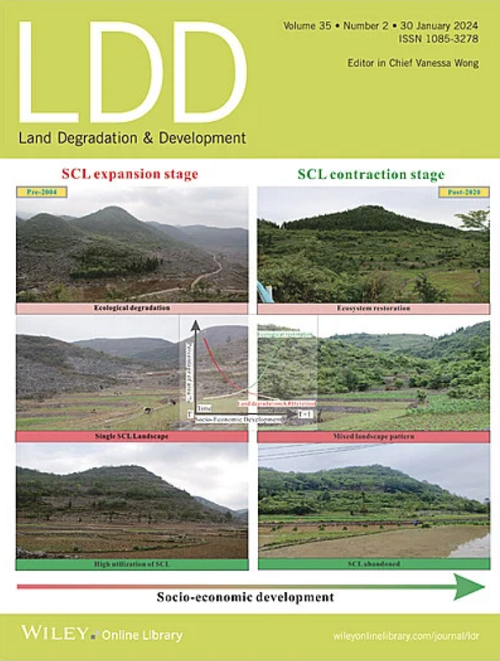西部丘陵区耕地破碎化与生态安全的空间关联及影响
IF 3.7
2区 农林科学
Q2 ENVIRONMENTAL SCIENCES
引用次数: 0
摘要
耕地破碎化问题的持续存在日益凸显出耕地生态系统的脆弱性。研究ALF影响生态安全的机制对于确保这些生态系统的长期稳定至关重要。在本研究中,我们分别对西部丘陵区的耕地生态安全和耕地退化程度进行了评价。然后,我们分析了这两个因素之间的空间相关性。此外,还采用计量经济模型考察了ALF对生态安全的影响。结果表明,辽西丘陵区ALF和生态安全的平均值分别为0.13和0.26,总体处于较低水平。ALF与生态安全呈显著负相关,相关系数为- 0.25。其中,面积破碎化(AFI)、形状破碎化(SFI)和分布破碎化(DFI)均对生态安全产生不利影响,其中DFI的负面影响最为明显。DFI指数每增加1个单位,生态安全降低0.05个单位。本研究旨在解决耕地破碎化问题,从而提高耕地生态安全。研究结果对我国耕地资源的可持续发展具有重要意义。本文章由计算机程序翻译,如有差异,请以英文原文为准。
Spatial Correlation and Impact of Arable Land Fragmentation and Ecological Security in the Western Hilly Region
The persistent issue of arable land fragmentation (ALF) has increasingly highlighted the vulnerability of arable ecosystems. Investigating the mechanisms through which ALF impacts ecological security is crucial for ensuring the long‐term stability of these ecosystems. In this study, we separately evaluated the ecological security of arable land and the extent of ALF in the Western Hilly region. We then analyzed the spatial correlation between these two factors. Additionally, an econometric model was employed to examine the impact of ALF on ecological security. The findings revealed that the average values for ALF and ecological security in the Western Hilly region of Liaoning Province were 0.13 and 0.26, respectively, indicating overall low levels. A significant negative correlation was observed, with a correlation coefficient of −0.25 between ALF and ecological security. Specifically, area fragmentation (AFI), shape fragmentation (SFI), and distribution fragmentation (DFI) all adversely affected ecological security, with DFI having the most pronounced negative impact. For every 1‐unit increase in the DFI index, ecological security decreased by 0.05 units. This study aims to address the issue of arable land fragmentation, thereby enhancing the ecological security of arable land. The results hold significant implications for the sustainable development of arable land resources.
求助全文
通过发布文献求助,成功后即可免费获取论文全文。
去求助
来源期刊

Land Degradation & Development
农林科学-环境科学
CiteScore
7.70
自引率
8.50%
发文量
379
审稿时长
5.5 months
期刊介绍:
Land Degradation & Development is an international journal which seeks to promote rational study of the recognition, monitoring, control and rehabilitation of degradation in terrestrial environments. The journal focuses on:
- what land degradation is;
- what causes land degradation;
- the impacts of land degradation
- the scale of land degradation;
- the history, current status or future trends of land degradation;
- avoidance, mitigation and control of land degradation;
- remedial actions to rehabilitate or restore degraded land;
- sustainable land management.
 求助内容:
求助内容: 应助结果提醒方式:
应助结果提醒方式:


